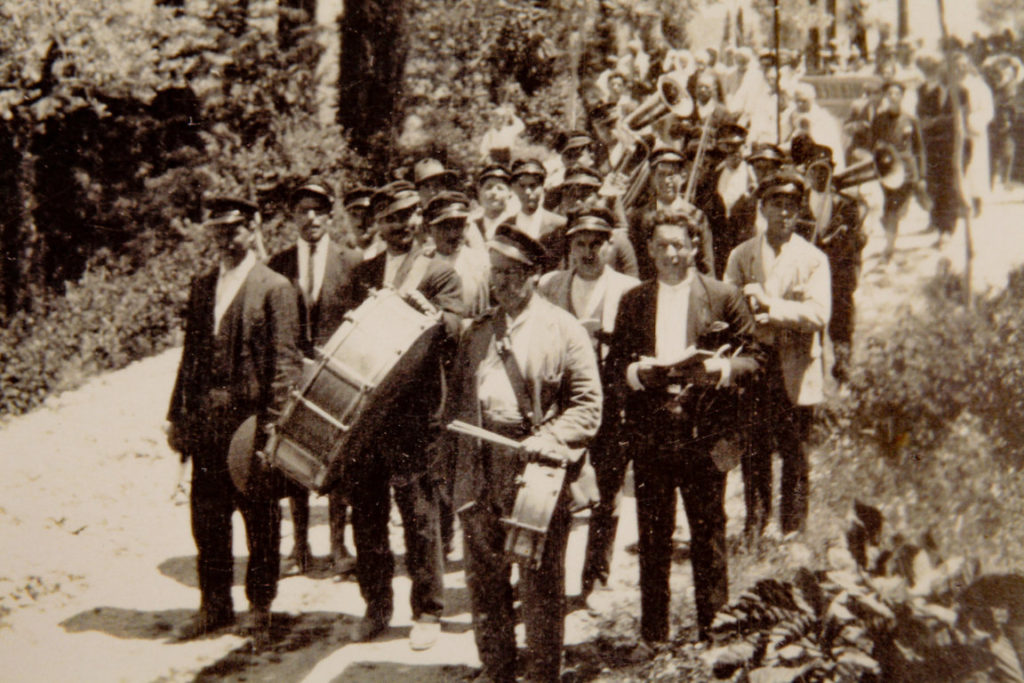The Musical Band of Mompeo and the Legacy of Alessandro Costa
The history of the Mompeo band dates back to the early 20th century, making it one of the oldest and longest-standing ensembles in the Sabina region. It was originally founded under the name Società Filarmonica.
Its foundation dates to 1912 and is credited to Alessandro Costa, a composer from the late 19th century and a figure deeply rooted in the history of Italian music. Costa served as an instructor to the town’s young people, teaching not only the basics of music but also how to read and write to a large segment of the population that was still illiterate. He founded the band with the intent of educating the boys and girls and steering them away from taverns—a principle echoed by many music educators in culturally and geographically distant contexts, such as the widely known José Antonio Abreu, creator of El Sistema in Venezuela, which aimed to counteract the spread of crime among young people in the favelas.
Even today, the youngest members of the band know who Alessandro Costa was, partly because the musical ensemble has established a competition named in his honour. This provides young people with an opportunity to pursue musical studies and encourages new generations to join the band, continuing the work of their founder.
Musically speaking, Alessandro Costa’s work—human and humanistic at once—has also been rediscovered in recent times and was presented to the local public for the first time in 2024. The Fondazione Maitreya and the Municipality of Mompeo launched an initiative that included two full days of tribute to Costa’s intellectual and musical legacy, featuring conferences and concerts.
The current band director, Marcello Ciccone, took on the task not only of conducting but also of deciphering and transcribing Costa’s often difficult-to-read scores for the instrumentalists, who performed the pieces for the first time on March 23rd, 2024, at the San Carlo Auditorium in Mompeo.
Thus, the legacy of Alessandro Costa counts among Mompeo’s intangible heritage. The transmission of his work—emotional and human on one side, musical and scholarly on the other—continues to be carried forward, forming part of the collective memory shared by generations far removed in time. This temporal distance is bridged in the present when, for example, Costa’s music is finally heard by the ears of elderly residents who knew him in life but had never had the opportunity to listen to his compositions.
The musical band itself is, more than any other institution, the living symbol of his legacy, keeping his memory alive at every rehearsal held in San Nicola Hall, the place dedicated to music in Mompeo since Alessandro Costa’s time.
The band is also a music school—an aspect that is not only socially and educationally valuable but also concretely functional to the life of the town. This includes the restoration of San Nicola Hall (an ancient, deconsecrated church from the 1100s) and its contribution to the current administration’s policy of making Mompeo a “village of hospitality.”
Historically, the band has attracted amateur musicians from across the Sabina territory and beyond, encouraging the return—however occasional—of Mompeo’s emigrants to their native village and renewing their emotional bond with the place each time.
A deep sense of belonging to the Mompeo band is strongly felt among the younger members as well, who are aware of the responsibility they bear in breathing life into this historic institution, often in continuity with their own family traditions.
The history of the Mompeo musical band is therefore also a story of resilience—sustained by the entire community, which has never ceased to recognize its central role in the life of the town, both from an educational and social standpoint, and from a symbolic-ritual and religious perspective, intrinsically linked to the feast of the patron saint.
It is traditional for the band to parade through the town on the Saturday morning of the festival, a procession that begins even before 6 am with the “wake-up call”, as the musicians gather before dawn to announce the start of the celebration to the sleeping village.
This awakening by music, heralding the long-awaited festival days, is yet another ancient rite steeped in symbolism. The wake-up call marks not only the beginning of the celebration but also the entry into ritual time—a liminal moment, that of dawn, laden with symbolic meaning in many ancient civilizations. It represents the threshold between ordinary and sacred time, a moment amplified by the sound of brass instruments, long used across cultures to accompany solemn ceremonies, with references found even in sacred scriptures—from the Annunciation by Gabriel to the Virgin Mary to epochal events such as the fall of the city of Babel, or the better-known passage from the Book of Revelation.
The sacred nature of Mompeo’s band association thus appears to be a foundational identity trait of the village, one likely to endure despite the challenges of maintaining the organization’s financial sustainability, which, like many small-town bands, relies on self-management.
The true resource for these small yet resilient realities lies not only in continued community support but also in generational renewal. In Mompeo’s case, a notable age diversity within the band members fosters the transmission of musical experience and practice by seasoned musicians, fostering meaningful intergenerational dialogue.
This element has been included in the Register of Intangible Heritage of local interest of the Municipality of Mompeo, as part of Intervention 4 “Activation of the Observatory on the Intangible Cultural Heritage of the Territory through the application of the REIL methodology – Register of Intangible Heritage of Local Interest”, within the “ MOMAC – MOMPEO UN MODELLO DI ACCOGLIENZA” project, funded by the NRRP (National Recovery and Resilience Plan), Mission: Digitalisation, innovation, competitiveness, culture and tourism, Component: Tourism and culture 4.0, Investment 2.1 “Attractiveness of villages” CUP C79G22000000006.


